Nvidia GeForce RTX 3060 Ti Founders Edition review: Spectacular 1440p - davidsonagainto

Brad Chacos/IDG

At a Glance
Expert's Rating
Pros
- Spectacular 1440p gambling
- Faster than RTX 2080 Super for 50% less
- 8GB of memory is good for 1440p
- Enthusiastic ray trace public presentation with DLSS
- Cool, fairly quiet custom cooling
- Nvidia software: Reflexive, G-Sync, Shadowplay, Broadcast, RTX IO, DLSS
Cons
- Not as serenity as early RTX 30 Founders Edition GPUs, some custom cards
- 12-pin power adaptor is ugly
- 8GB of GDDR6 memory limits future 4K gaming potential
Our Verdict
Nvidia's GeForce RTX 3060 Ti is faster than final stage-generation's RTX 2080 Super for half the price, delivering spectacular 1440p gaming performance for $400. Ray tracing and Nvidia's software features are top-notch, but minor quibbles endure in Nvidia's Founders Edition design
Optimum Prices Nowadays

$400

$1,329.98
After a high-end shootout between Nvidia and AMD resulted in not combined, not cardinal, but six different graphics cards released with sky-high $500+ price tags, the next generation is finally trickling down to more affordable price points with the launch of the GeForce RTX 3060 Ti on December 2. This first-class GPU may actually be the most exciting first appearance in Nvidia's RTX 30-series yet.
At $400, the RTX 3060 Te costs significantly more than the 60- and 70-separate GeForce options of yesteryear (anybody remember the $330 GTX 970 and $380 GTX 1070?), continuing a trend we've seen in recent graphics card families. But if you can count erstwhile the mention, you'll find the GeForce RTX 3060 Ti delivers a lot of value, pumping outgoing frames faster than last generation's $800 GeForce RTX 2080 Super—the second-fastest artwork card in the ma up until a few months ago—for half the price. Yes, that includes beam of light tracing performance. Nvidia's up-to-the-minute graphics card soundly rings the expiry knell for older, similarly priced graphics cards like the Radeon RX 5700-series and the GeForce RTX 2060 Super.
Nowadays, we're digging into Nvidia's GeForce RTX 3060 Ti Founders Edition, priced straightforwardly at this GPU's $400 MSRP. Giddy-up.
GeForce RTX 3060 Ti eyeglasses, features, and design
 Brad Chacos/IDG
Brad Chacos/IDG Dissimilar the GeForce RTX 3090, RTX 3080, and RTX 3070 reviews, this one is pretty straightforward. The GeForce RTX 3060 Ti features a cut-thrown version of the $500 RTX 3070's "GA104" GPU, based on the company's new "Ampere" graphics computer architecture. Nvidia's many affordable carte packs roughly 17 percent fewer simultaneous multiprocessors (SMs), a ratio that carries over to the CUDA cores, RT cores, tensor cores, and texture units found within those SMs. Nvidia also cut down the render output unit (ROP) count by roughly the similar margin.
The GeForce RTX 3060 Ti includes the hardware counts shown in the Nvidia-supplied chart below, which compares the new GPU against last genesis's GeForce RTX 2060 Super and the aforesaid 3070. It's Worth noting that the newer RT and tensor cores in the RTX 30-series, paired with the high raw performance of these GPUs, deliver vastly improved ray tracing performance compared to the 2060 Super, even though the 3060 Ti offers outlying fewer tensor cores and a similar RT core count. (We dove deeper into International ampere's ray of light trace and DLSS performance in our RTX 3080 review.)
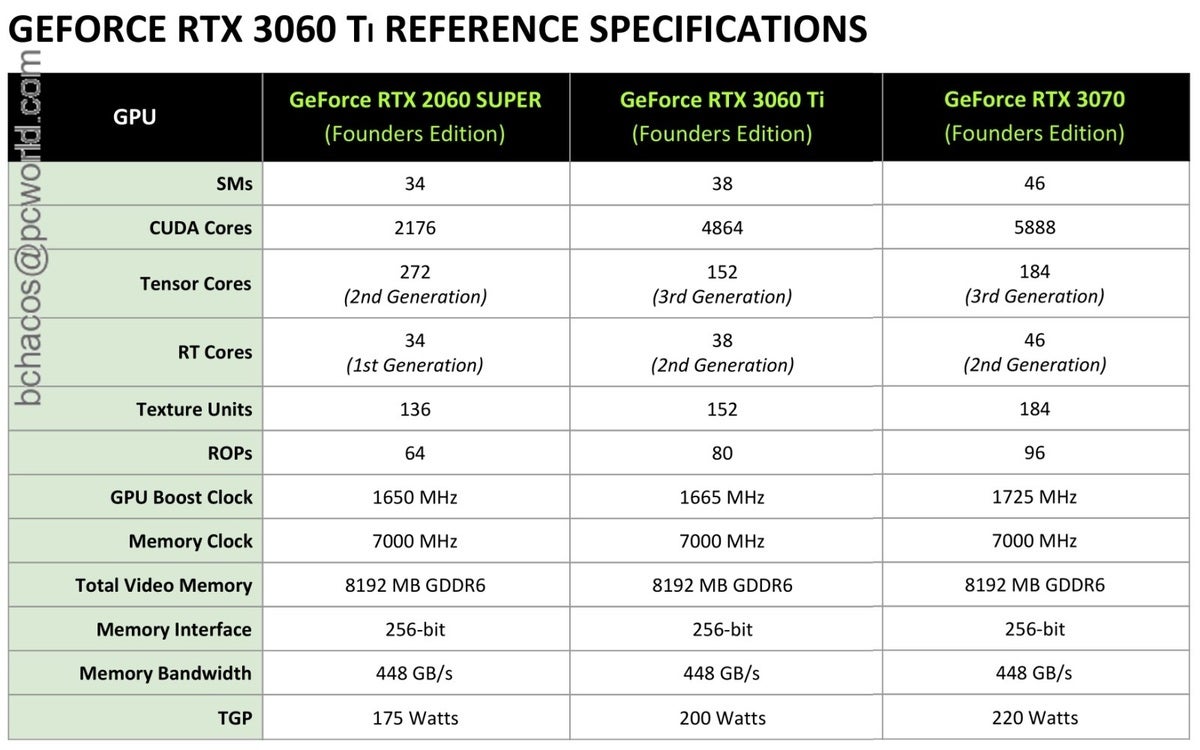 Nvidia
Nvidia The GeForce RTX 3070 also runs a bit faster, with a 1,725MHz Boost clock zip versus the RTX 3060 Ti's 1,665MHz rating. In praxis, though, all Nvidia card game top their rated speeds with help from the GPU Boost feature, which takes your graphics card's thermals and baron into consideration to bump up speeds automatically. Factoring in all the tweaks, the GeForce RTX 3060 Ti consumes slimly less power than its bigger sibling, but yet more power than penultimate-gen's RTX 2060 Super, splitting the difference with a 200-watt rating. That reveals Ampere's improved efficiency, still, As the RTX 2080 Tops that this GPU outguns was rated for 250W.
Nvidia carried the air-filled memory configuration of the RTX 3070 cut down to the RTX 3060 Ti, equipping the new GPU with 8GB of GDDR6 memory across a 256-routine double-decker, for a total memory bandwidth of 448GB/s. That's a o.k. come for the 1440p gaming this graphics card targets, and a smart move by Nvidia as touch Radeon RX 6000-serial publication cards look up self-possessed to gain unprocessed capacity while leveraging their groundbreaking Infinity Cache passim AMD's entire lineup. The non-Super RTX 2060 launched in 2018 with 6GB of GDDR6 memory, but that more limited amount probably won't hold up well as modern font games get more straining, peculiarly when ray trace is active.
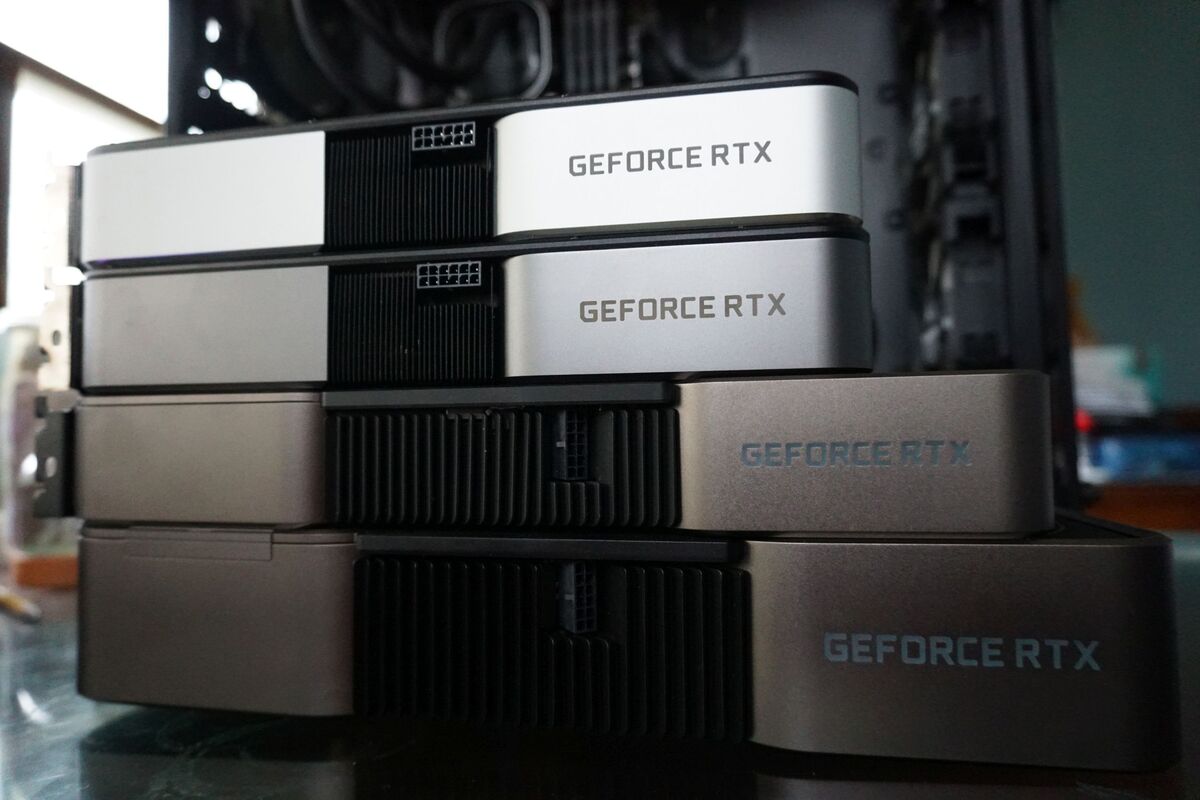 Brad Chacos/IDG
Brad Chacos/IDG Nvidia's on-going GeForce RTX 30-series Founders Edition product mass. (Hey-o!) From top: RTX 3060 Ti, 3070, 3080, 3090.
Plan-wise, the GeForce RTX 3060 Titanium Founders Edition mirrors Nvidia's RTX 3070 FE, but its outward shroud is a hoy shade of silver, as opposed to the much gunmetal-the like sheen of the higher-end models. That means it's a standard 2-time slot, 9.5-inch size, and much littler than the Founders Edition coolers found on Nvidia's higher-end RTX 3080 and 3090. Here's how we delineate the RTX 3070 FE's tank:
"The Founders Version model we're reviewing today still uses Nvidia's tiny, highly customized PCB with a notch taken out of it to help with flow of air. This means that like the other Atomic number 26 card game revealed then far, information technology powers on via a proprietary 12-pin connector. Nvidia includes an (ugly, short) adaptor in the box. Unequal the more powerful RTX 30-series Founders Edition card game, however, the 12-pin connexion is set horizontally in the midst of the edge of the add-in, rather than positioned vertically and at a 45-degree lean on. If your case's mogul supply cover has a cutout for wires underneath your GPU, this is a much better placement."
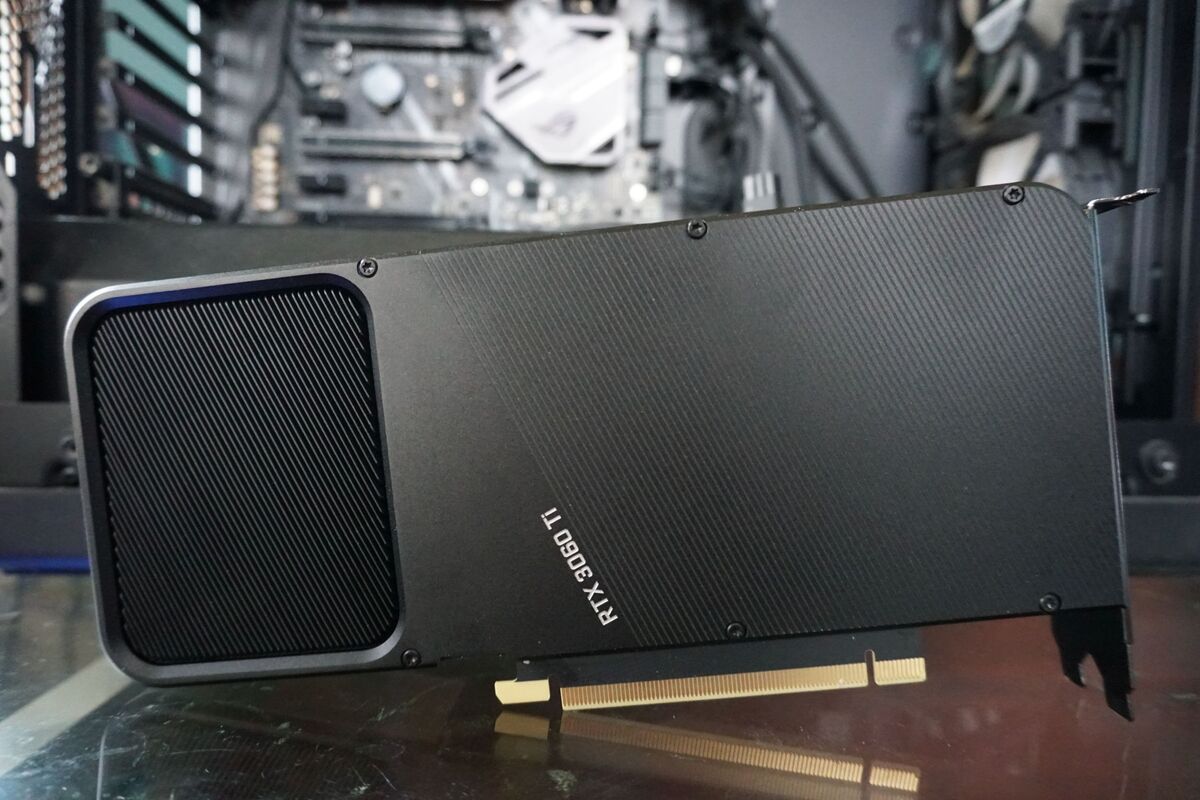 Brad Chacos/IDG
Brad Chacos/IDG "That's not the only design change. Nvidia created a highly singular custom 'flow-direct' cooling solution for the RTX 3080 and RTX 3090, with independent get-up-and-go-pull fans and bristling, abundant metal heating fins comprising the body of the carte itself. It's very effective.
The GeForce RTX 3070 [and 3060 Cordyline terminalis—Ed.] changes things up a wee bit. Rather than having one buff on the top and the bottom of the card in a push-pull configuration, the RTX 3070 Iron places both fans in their standard places in the font of the card and adds a sleek backplate to the top. The two fans pushes air through the heatsink; the blower-style fan at the rear of the card expels heat through the I/O bracket, piece the early one sends the hot air through a turn out-out in the backplate back into the top of your system of rules, where it can be sucked out away your pillow slip's rear outtake fan. Information technology's functionally the equivalent idea arsenic the tank on the more powerful RTX 30-series cards, but it takes a different path to get there."
 Brad Chacos/IDG
Brad Chacos/IDG Port report
Nvidia kept the display outputs the same as well, with three DisplayPort 1.4 connections and a man-to-man HDMI 2.1 port adequate to of 144Hz 4K surgery 8K60 video output over a single cable, along with AV1 decode funding for watching 8K videos without stutter or dropping frames. Rival Radeon RX 6000-series graphics cards match that loadout, but swap one of the DisplayPorts for USB-C. The usage PCB inside the 3060 Te ISN't quite equally exotic as the V-notched version found in the RTX 3080 and 3090, just IT remains much shorter than typical.
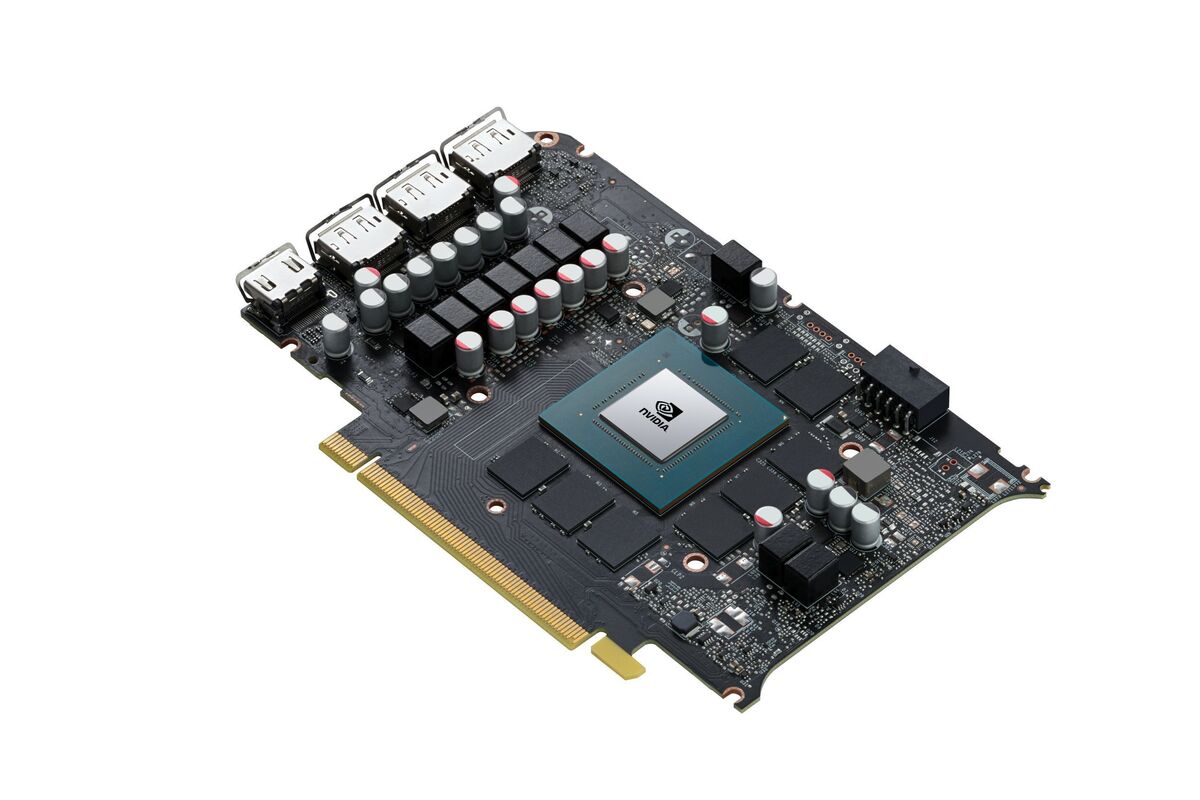 Nvidia
Nvidia Course, the GeForce RTX 3060 Ti supports whol Nvidia's extensive software features, or s of which are truly killer apps for specified uses. Streamers will appreciate the best-in-class NVENC GPU encoder and the AI-enhanced Nvidia Broadcast suite, esports competitors will jibe the Nvidia Reflex suite, and content creators swear by CUDA and Optix optimizations in prosumer apps. The graphics card comes equipped with a up-to-date PCIe 4.0 connection (though solely modern Ryzen platforms bear out it right now). The card bequeath also support RTX I/O, an approaching technology built upon Microsoft's DirectStorage API that allows your GPU and NVMe SSD to talk direct, obliterating game-consignment times on the PC.
Finally, information technology's worth noting that Nvidia's more mature ray tracing technology outperforms the commencement-gen implementation in AMD's equal Radeon RX 6000-series graphics cards. It likewise gets a huge shooting in the arm with Nvidia's Deep Learning Super Sampling (DLSS) feature, which helps regain frames lost to ray trace's heavy impact. AMD has no answer for it yet. If you want the best irradiatio tracing graphics card game, Team Green is a no-brainer.
Got it? Good. Let's get gaming.
Next page: Our test system, gaming benchmarks begin
Our test system
Our devoted graphics card trial system is a couple of years old, but it's packed with some of the fastest complementary components available to put any potential performance bottlenecks squarely on the GPU, especially at the higher resolution these nontextual matter cards fair game. Most of the hardware was provided by the manufacturers, merely we purchased the tank and storage ourselves.
- Intel Congress of Racial Equality i7-8700K central processor ($300 connected Amazon) overclocked to 5GHz all cores
- EVGA CLC 240 blinking-loop liquid cooler ($105 on Virago)
- Asus Maximus X Hero motherboard
- 64GB HyperX Vulture RGB DDR4/2933 ($355 on Amazon)
- EVGA 1200W SuperNova P2 exponent provision ($352 on Amazon)
- Corsair Crystal 570X RGB case, with front and top panels removed and an special rear lover installed for better airflow
- 2x 500GB Samsung 860 EVO SSDs ($70 each on Amazon)
We're comparing the $400 GeForce RTX 3060 Ti Founders Variant against Nvidia's Founders Edition models of the $500 GeForce RTX 3070 and last-generation's $350 RTX 2060, $500 RTX 2070, and $800 2080 Super. We opted to include the 2080 Large over the not-Super version, every bit this is the card Nvidia compares against the RTX 3060 Ti. We've too included benchmarks for AMD's new $580 Radeon RX 6800 and hold up-gen $400 Radeon RX 5700 XT.
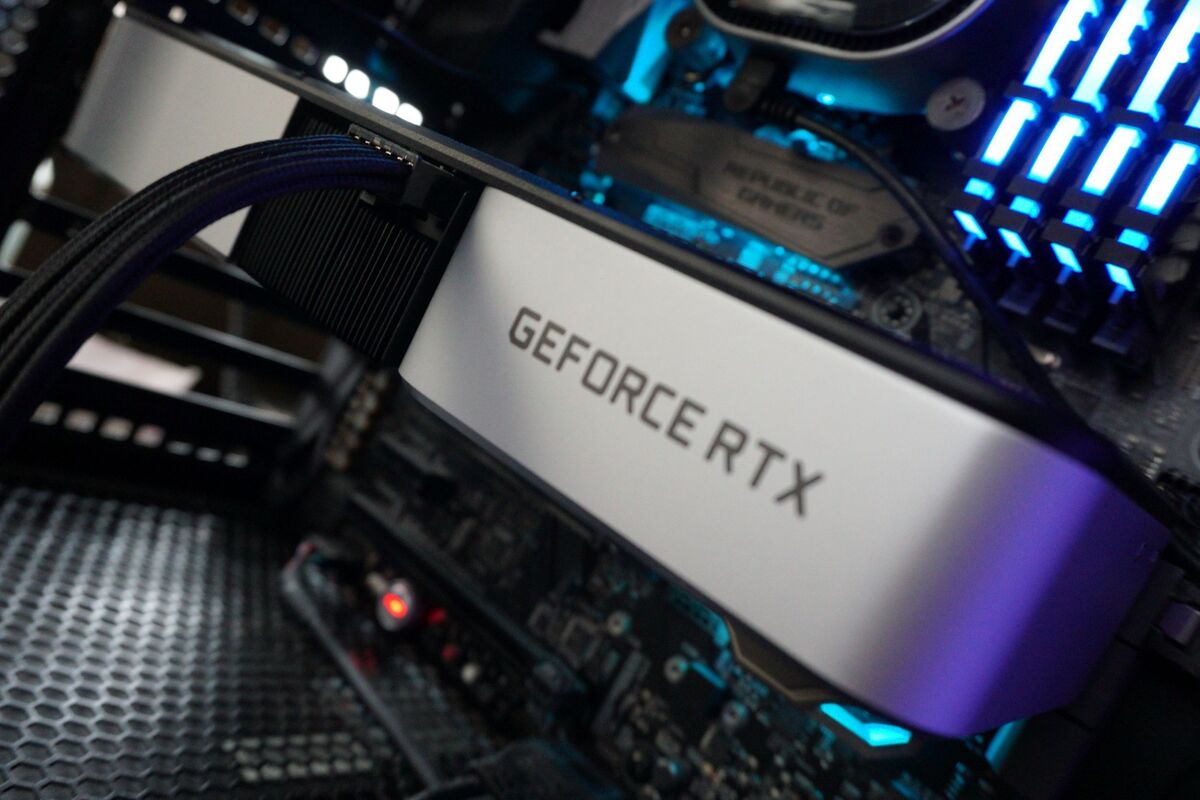 Brad Chacos/IDG
Brad Chacos/IDG The GeForce RTX 3060 Ti in our mental testing organisation.
We test a diverseness of games spanning various engines, genres, vendor sponsorships (Nvidia, AMD, and Intel), and graphics Apis (DirectX 11, DX12, and Vulkan). Each game is tested exploitation its in-game bench mark at the highest possible graphics presets unless otherwise noted, with VSync, bod rate caps, real-time ray tracing operating theater DLSS effects, and FreeSync/G-Sync out of action, along with any new vendor-specific technologies like FidelityFX tools or Nvidia Reflex. We've also enabled temporal anti-aliasing (TAA) to push these cards to their limits. We run off each benchmark at to the lowest degree three times and lean the average result for each test.
Nvidia's claims prove true: The GeForce RTX 3060 Te indeed winds up a whiske faster than the last-gen RTX 2080 Super across the board—Wolfenstein Youngblood is the sole exclusion, and that interruption is very approximate. The older RTX 2060 Founders Edition gets absolutely massacred by Nvidia's new GPU. Surrendered that, we'll present these orthodox benchmarks without foster comment.
GeForce RTX 3060 Ti gambling benchmarks
Spotter Dogs: Legion
Watch Dogs: Legion is uncomparable of the ordinal games to debut along incoming-gen consoles. Ubisoft upgraded its Disrupt engine to include cutting-edge features like real-metre ray trace and Nvidia's DLSS. We incapacitate those effects for this testing, just Horde remains a strenuous back even on high-terminate ironware with its optional drunk-resolution texture coterie installed. Nobelium card can maintain a 60-frames-per-second average with Ultra art options enabled, and the game allocates more than 8GB of memory straight-grained at 1440p. Oof.
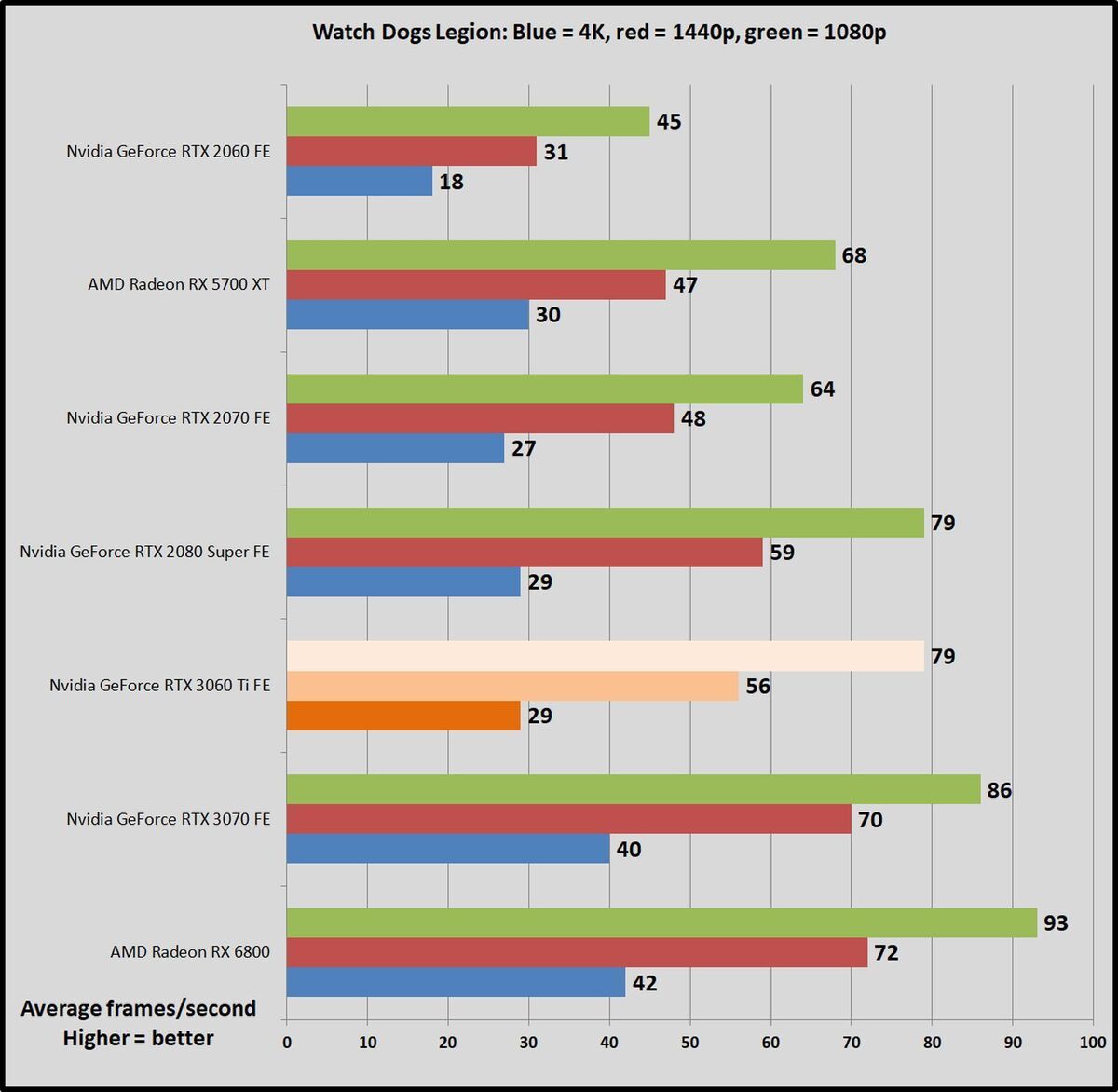 Brad Chacos/IDG
Brad Chacos/IDG Celestial horizon Zero Dawn
Yep, PlayStation exclusives are coming to the PC straight off. Horizon Zero Dawn runs on Guerrilla Games' Decima locomotive, the same railway locomotive that powers Death Stranding. Ambient Stoppage send away offer iffy results if ready to Ultra, so we test with that place setting at Medium. All other visual option is maxed out.
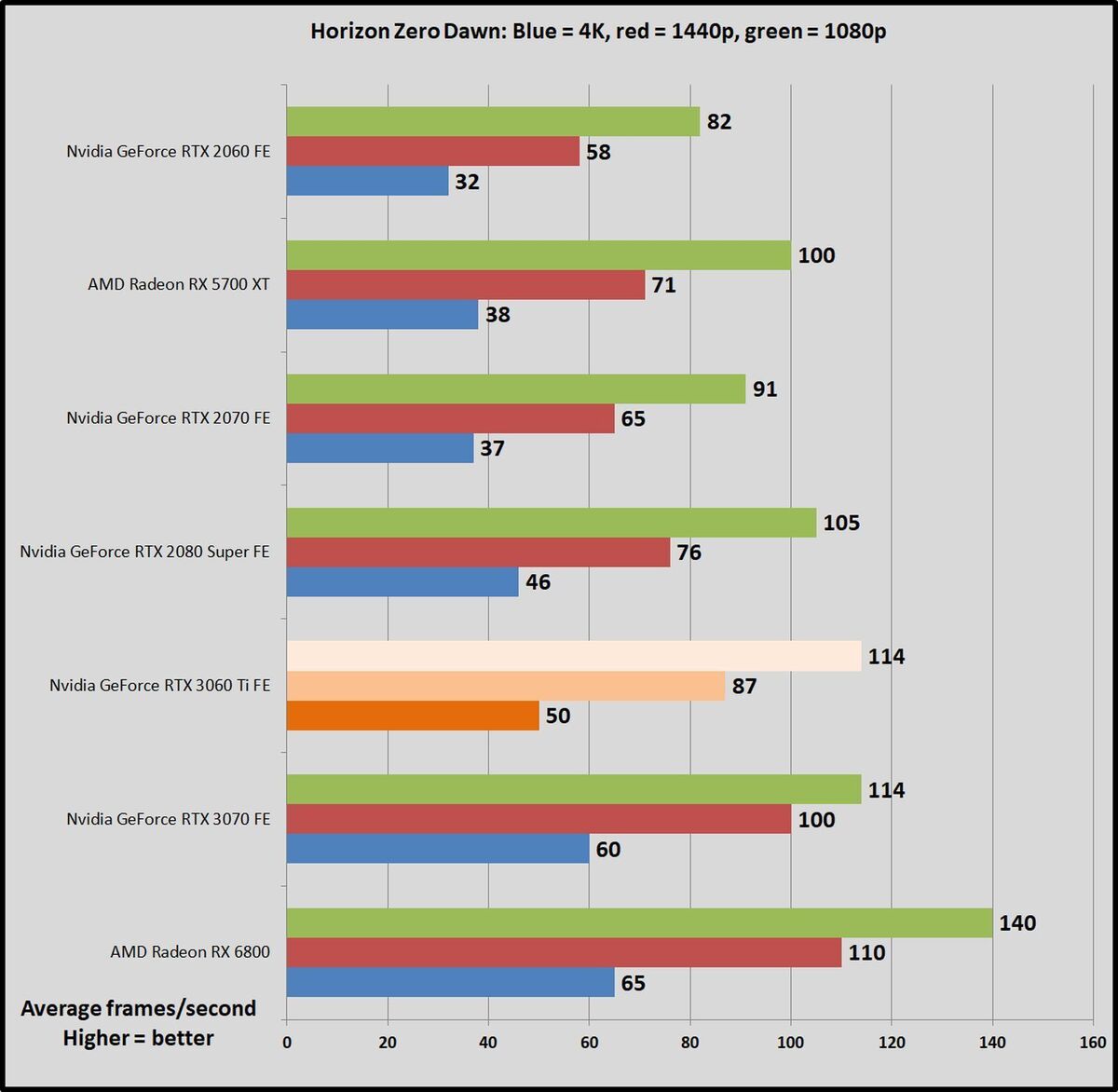 Brad Chacos/IDG
Brad Chacos/IDG Next page: Gaming benchmarks continue
Gears Maneuver
Gears Tactics puts it own fell, imperviable-paced spin on the XCOM-like literary genre. This Unreal Railway locomotive 4-powered game was built from the ground up for DirectX 12, and we love existence fit to make for a manoeuvre-style game into our benchmarking suite. Major yet, the lame comes with a superfluity of graphics options for PC snobs. More games should devote much loving care to explaining what flipping totally these seeable knobs mean.
You can't enjoyment the presets to benchmark Gears Tactics, every bit it intelligently scales to work best happening your installed hardware, meaning that "Immoderate" on one nontextual matter card can load different settings than "Ultra" on a weaker scorecard. We manually set apart all options to their highest possible settings.
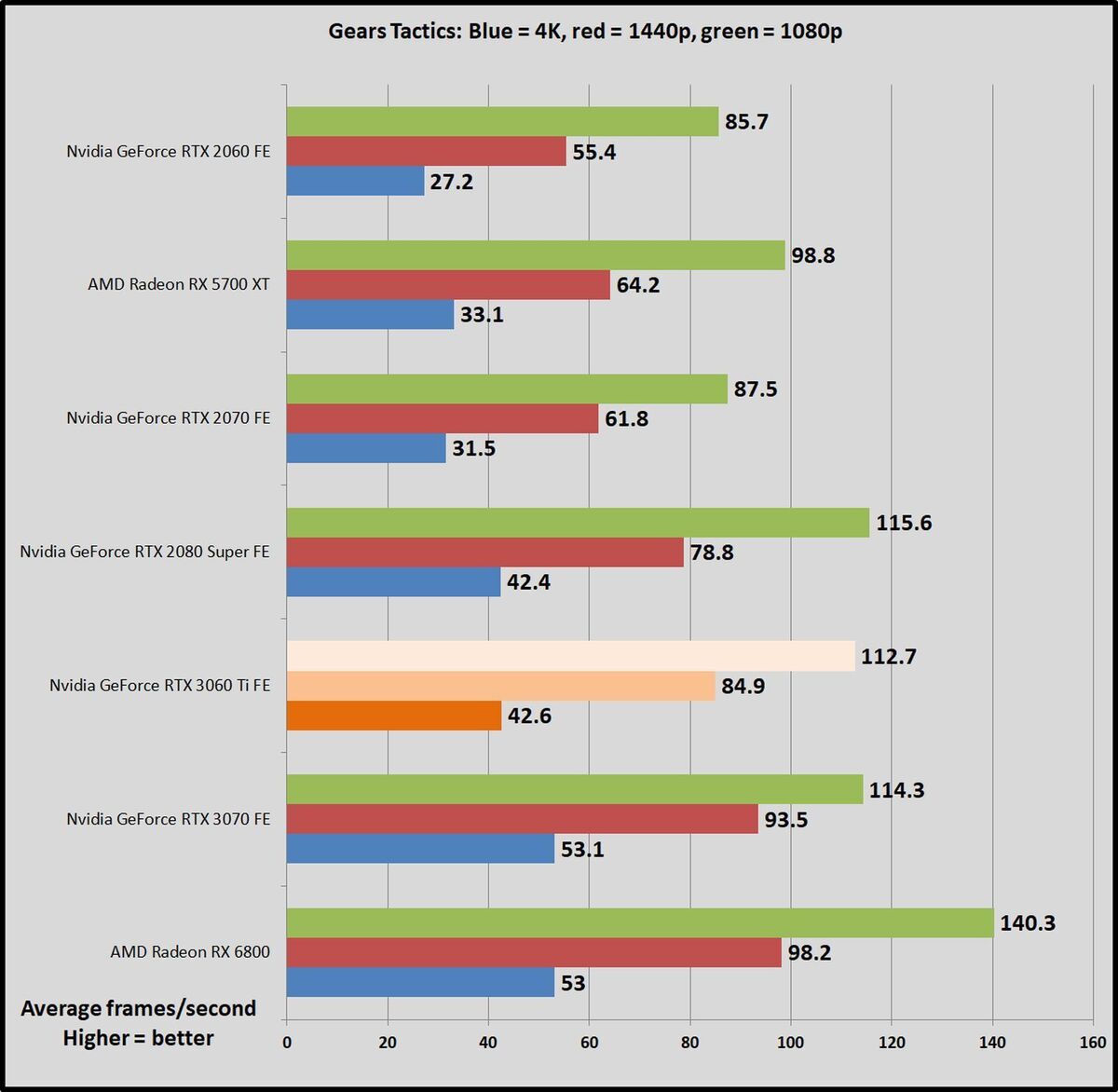 Brad Chacos/IDG
Brad Chacos/IDG Wolfenstein: Youngblood
Wolfenstein: Youngblood is more fun when you seat fun cooperatively with a buddy, but it's a fearless experiment—and an absolute subject field showcase. Working on the Vulkan API, Youngblood achieves critical frame rates, and it supports all sorts of raw-edge technologies like ray tracing, DLSS 2.0, HDR, GPU culling, asynchronous computing, and Nvidia's Content Adaptive Shading. The game includes a built-in bench mark with two different scenes; we dependable Lab X.
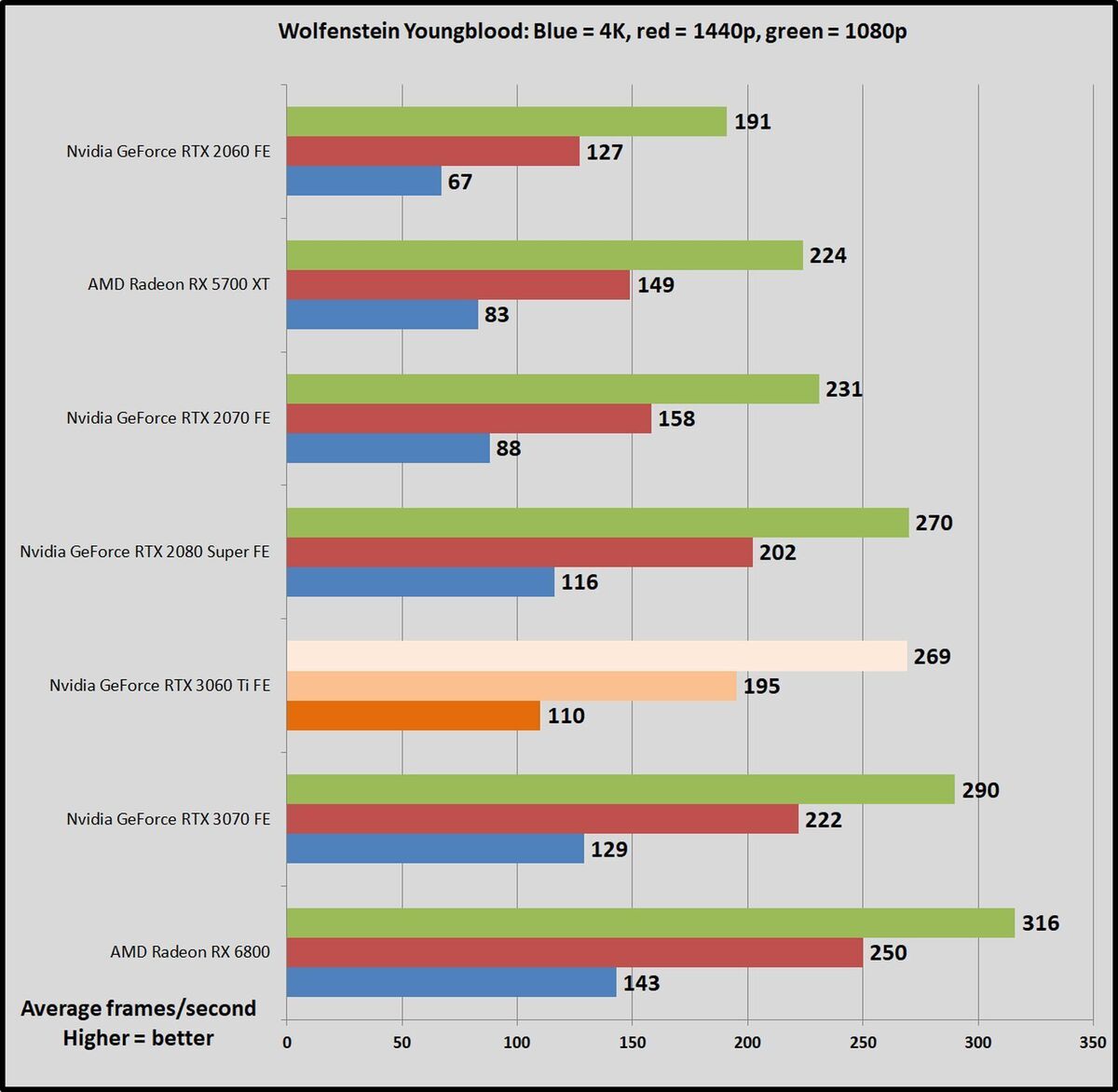 Brad Chacos/IDG
Brad Chacos/IDG Metro Exodus
Unrivalled of the best games of 2019, Subway Exodus is one of the scoop-looking games around, too. The latest version of the 4A Locomotive provides unbelievably luscious, ultra-detailed visuals, with one of the most arresting real-clock time ray tracing implementations discharged yet. We test in DirectX 12 mode with beam trace, Hairworks, and DLSS disabled for our basic benchmarks.
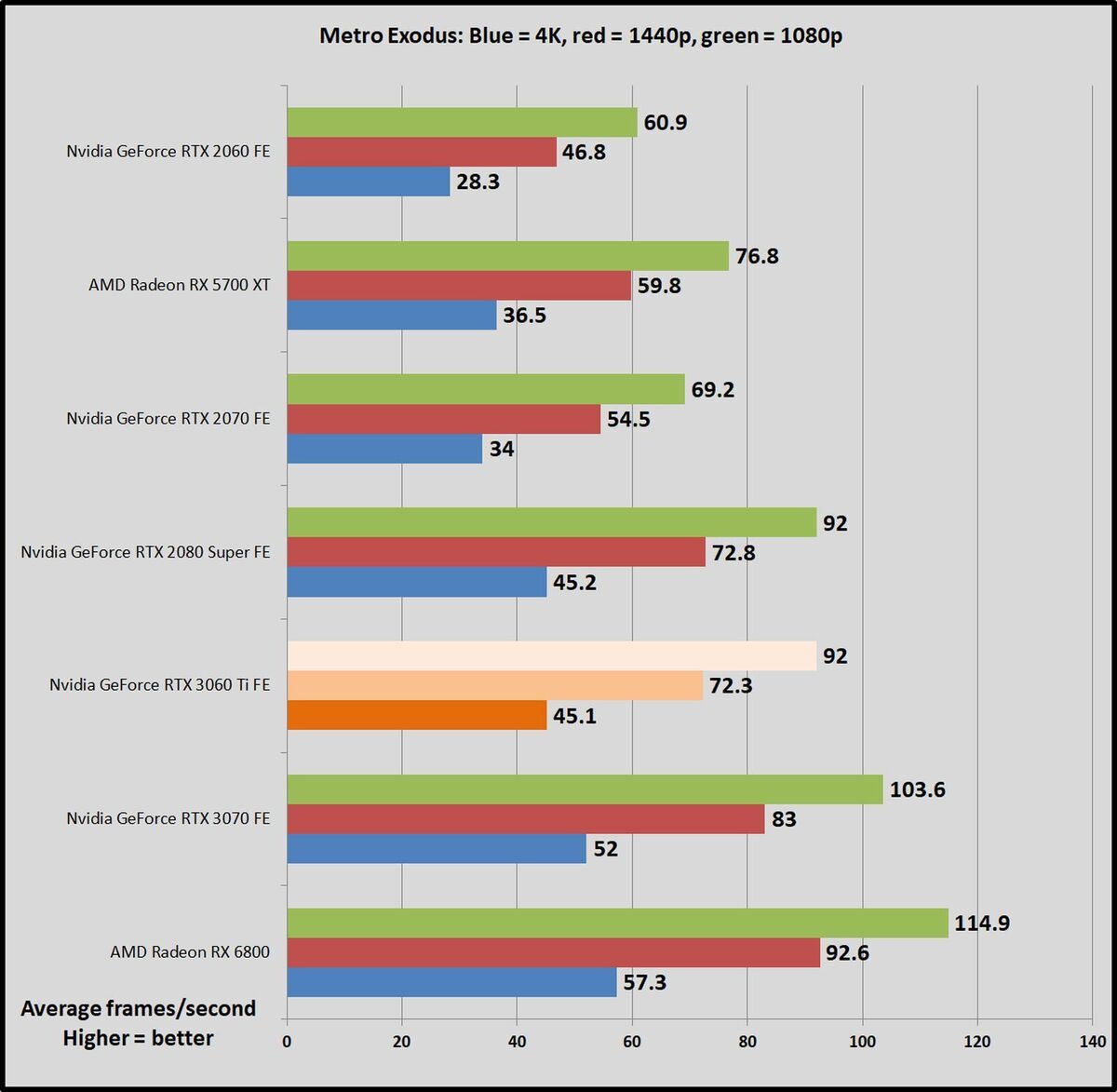 Brad Chacos/IDG
Brad Chacos/IDG Borderlands 3
Borderlands is back up! Gearbox's game defaults to DX12, and so we do as fortunate. It gives U.S.A a glimpse at the immoderate-popular Cardboard Engine 4's performance in a traditional shot.
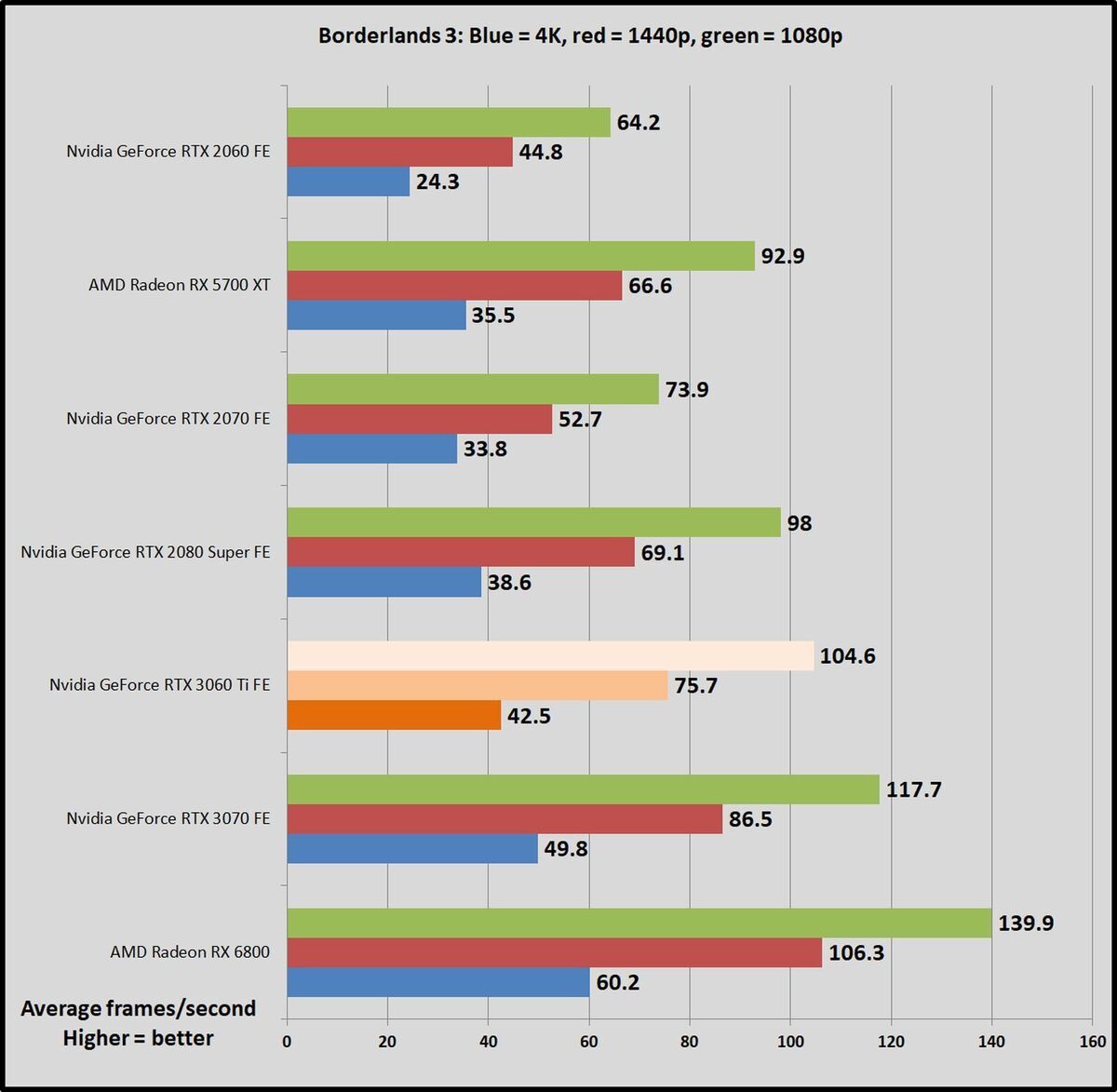 Brad Chacos/IDG
Brad Chacos/IDG Strange Brigade
Strange Brigade is a noncompetitive third-individual shooter where a team of adventurers blasts through hordes of fabulous enemies. It's a technological showcase, collective around the next-gen Vulkan and DirectX 12 technologies and infused with features like HDR support and the ability to toggle asynchronous compute off and on. It uses Rebellion's custom Azure engine. We psychometric test using the Vulkan renderer, which is faster than DX12.
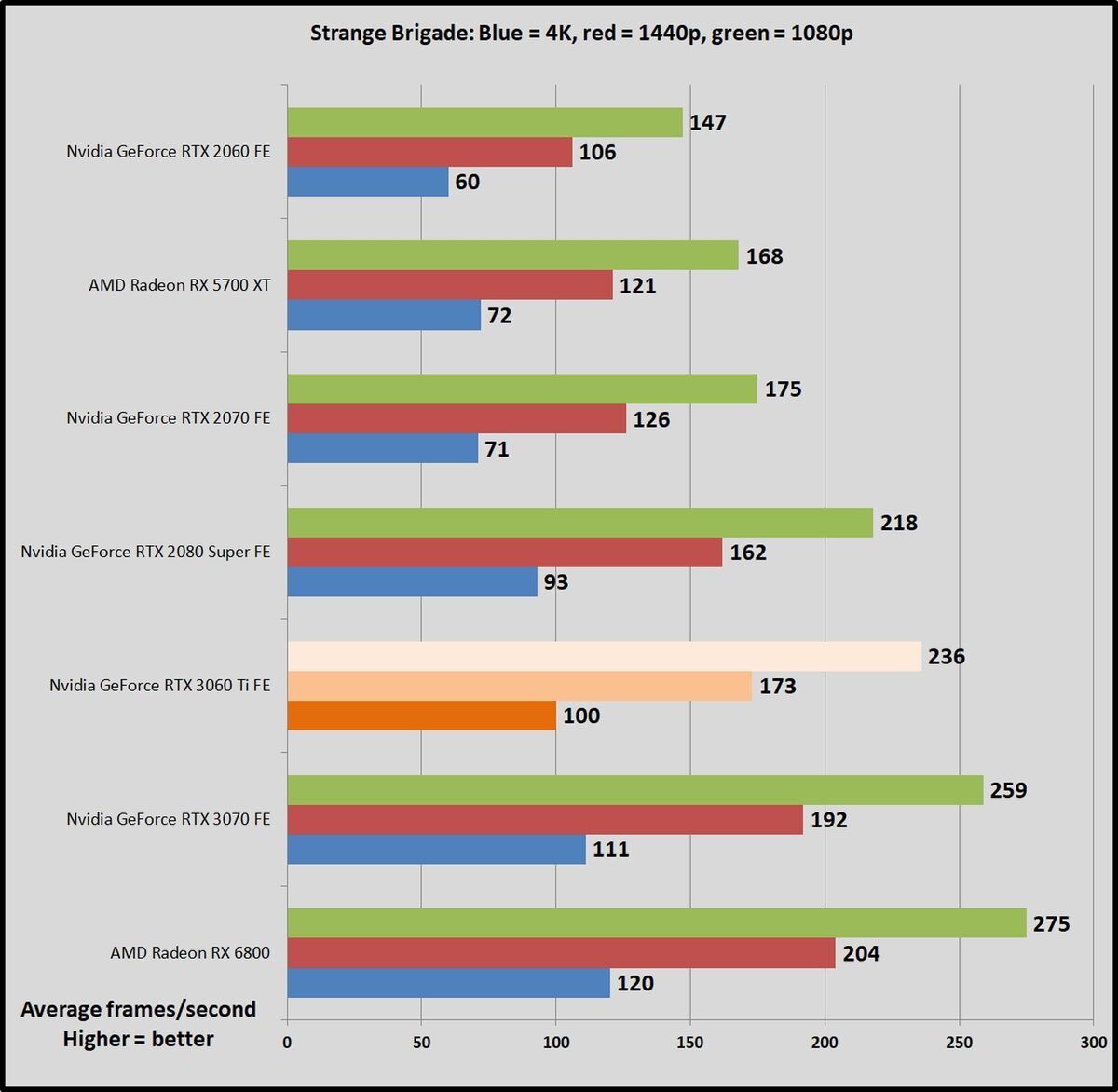 Brad Chacos/IDG
Brad Chacos/IDG Next page: Gaming benchmark continue
Summate State of war: Troy
The latest game in the popular Total War saga, Troy was given away free for its first 24 hours on the Epic Games Stash awa, moving all over 7.5 million copies before it went on proper sale. Total War: Iliu is built using a modified version of the Total War: Warhammer 2 engine, and this DX11 title looks stunning for a turn-based scheme game. We test the more intensive battle benchmark.
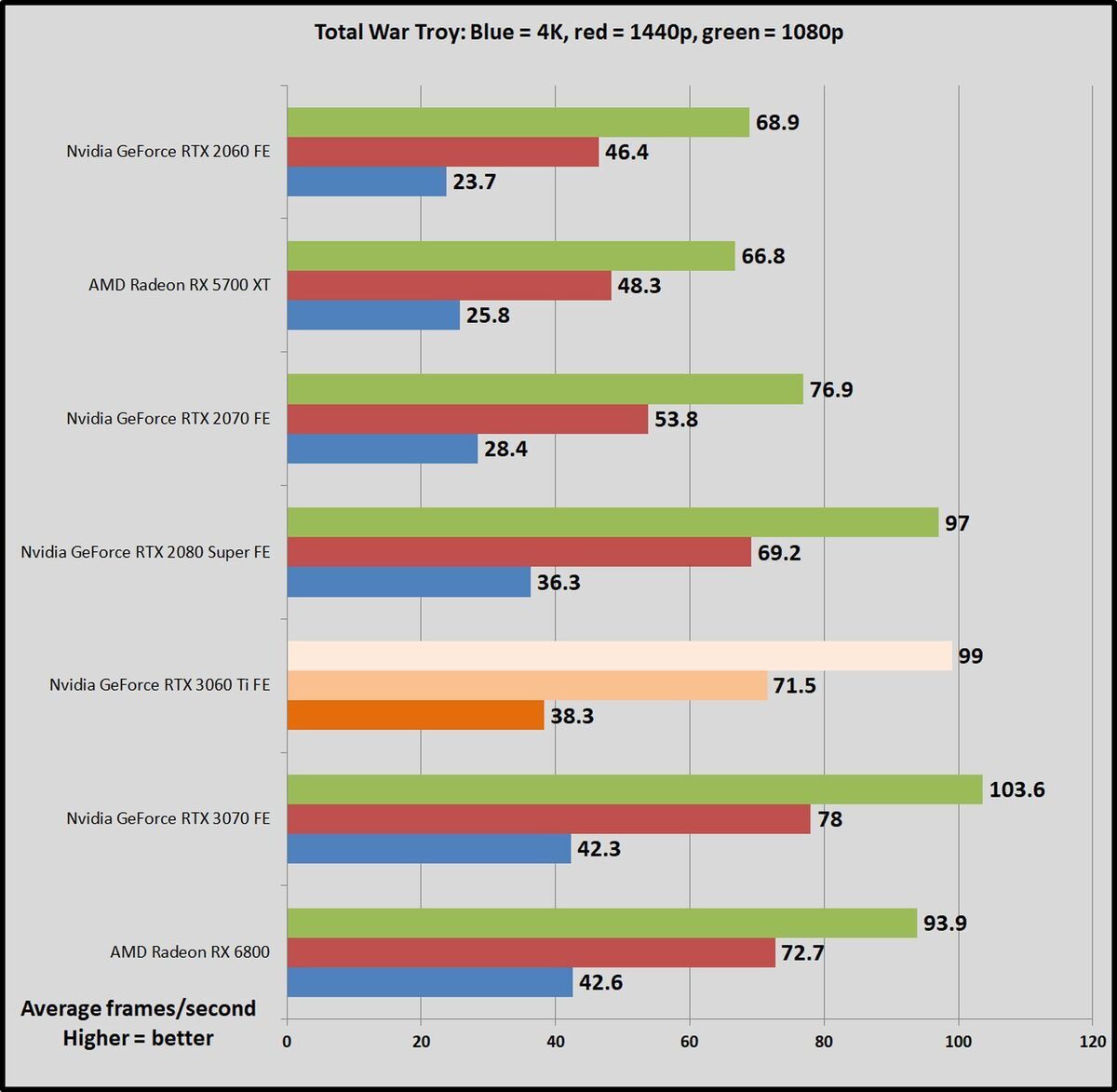 Brad Chacos/IDG
Brad Chacos/IDG F1 2020
The latest in a long line of work of fortunate racing games,F1 2020 is a stone to test, supplying a wide array of some graphical and benchmarking options, devising it a much more reliable (and fun) selection that theForzaserial publication. It's made-up on the latest version of Codemasters' buttery-smooth Ego game railway locomotive, complete with support for DX12 and Nvidia's DLSS technology. We test two laps on the Australia trend, with clear skies along and DLSS away.
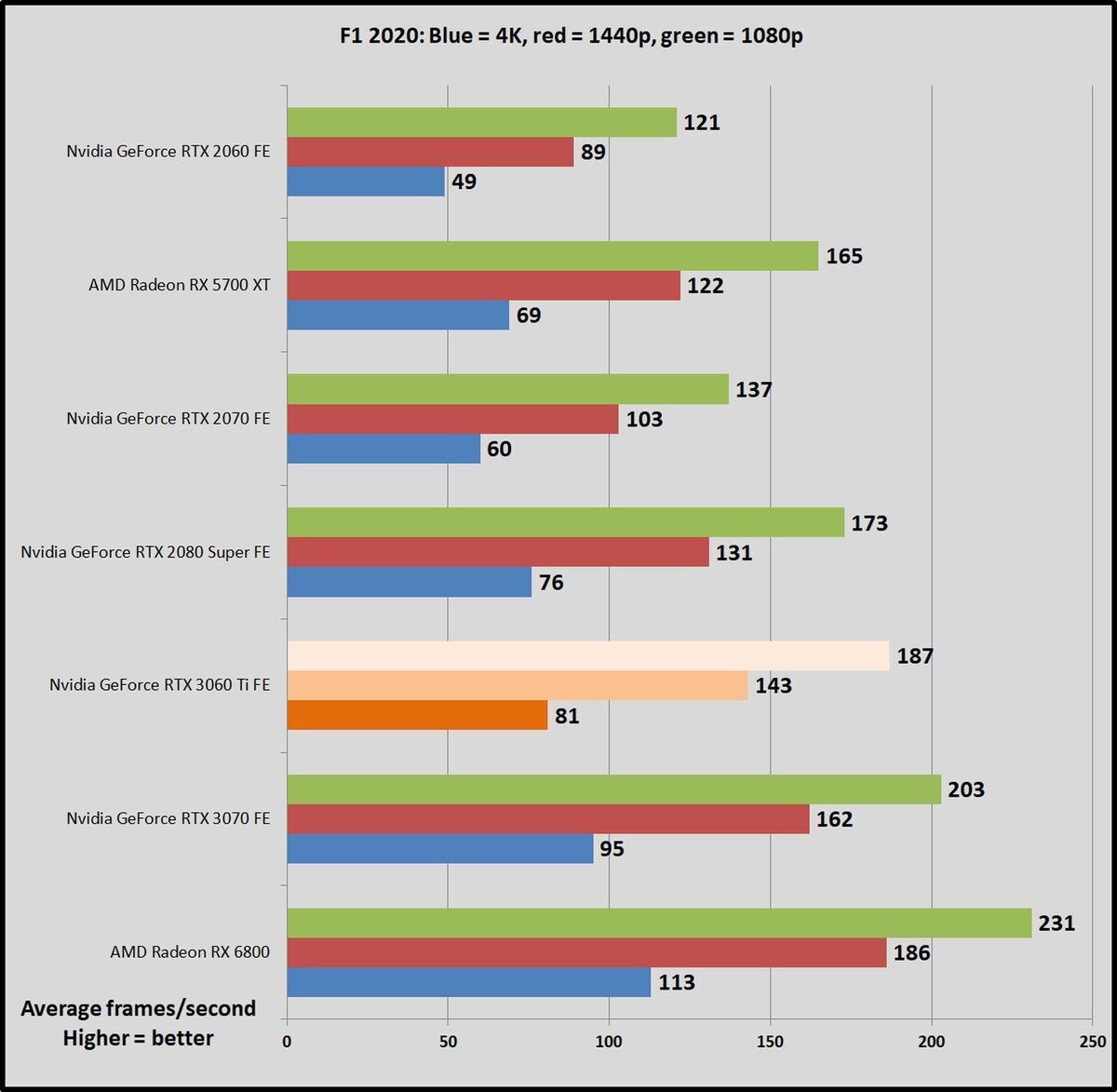 Brad Chacos/IDG
Brad Chacos/IDG Shadow of the Tomb Pillager
Dwarf of the Tomb Raider concludes the bring up trilogy, and it's utterlygorgeous. Square Enix optimized this game for DX12, and recommends DX11 only if you're using older hardware operating theatre Windows 7, so we test with DX12.Shadow of the Tomb Raider uses an enhanced adaptation of the Base engine that also poweredRise of the Tomb Looter and includes optional real-time ray tracing and DLSS features.
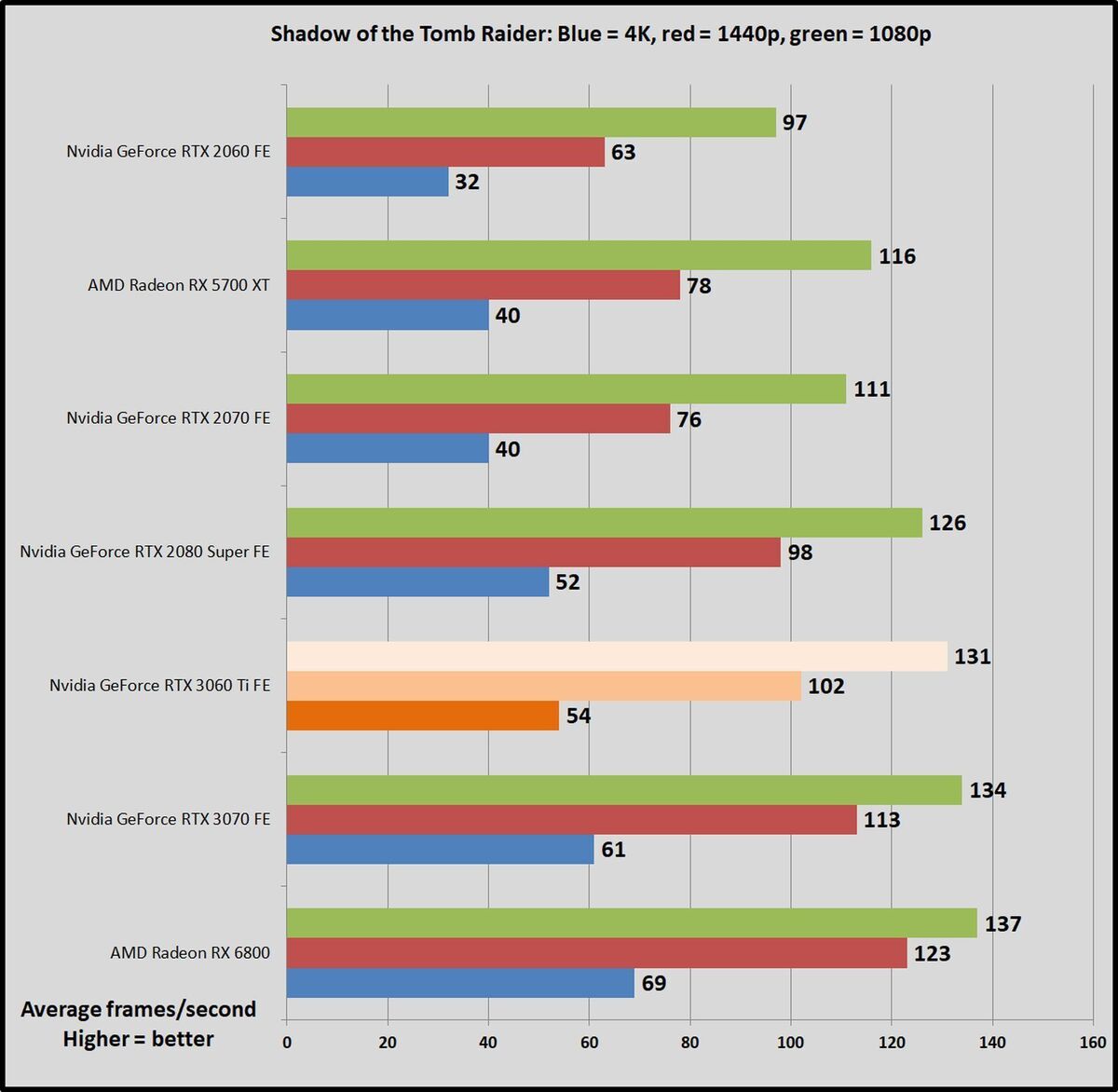 Brad Chacos/IDG
Brad Chacos/IDG Rainbow Six Siege
Care GTA V, Ubisoft's Rainbow Six Siege still dominates the Steam charts years after its set in motion, and it'll be getting a visual acclivity for the next-gen consoles. The developers receive poured a ton of work into the game's AnvilNext engine complete the years, eventually peal out a Vulkan adaptation of the courageous that we utilization to test. Past default, the game lowers the render scaling to increase frame rates, but we set it to 100 percent to bench mark native rendering performance on artwork cards. Flat still, frame rates soar.
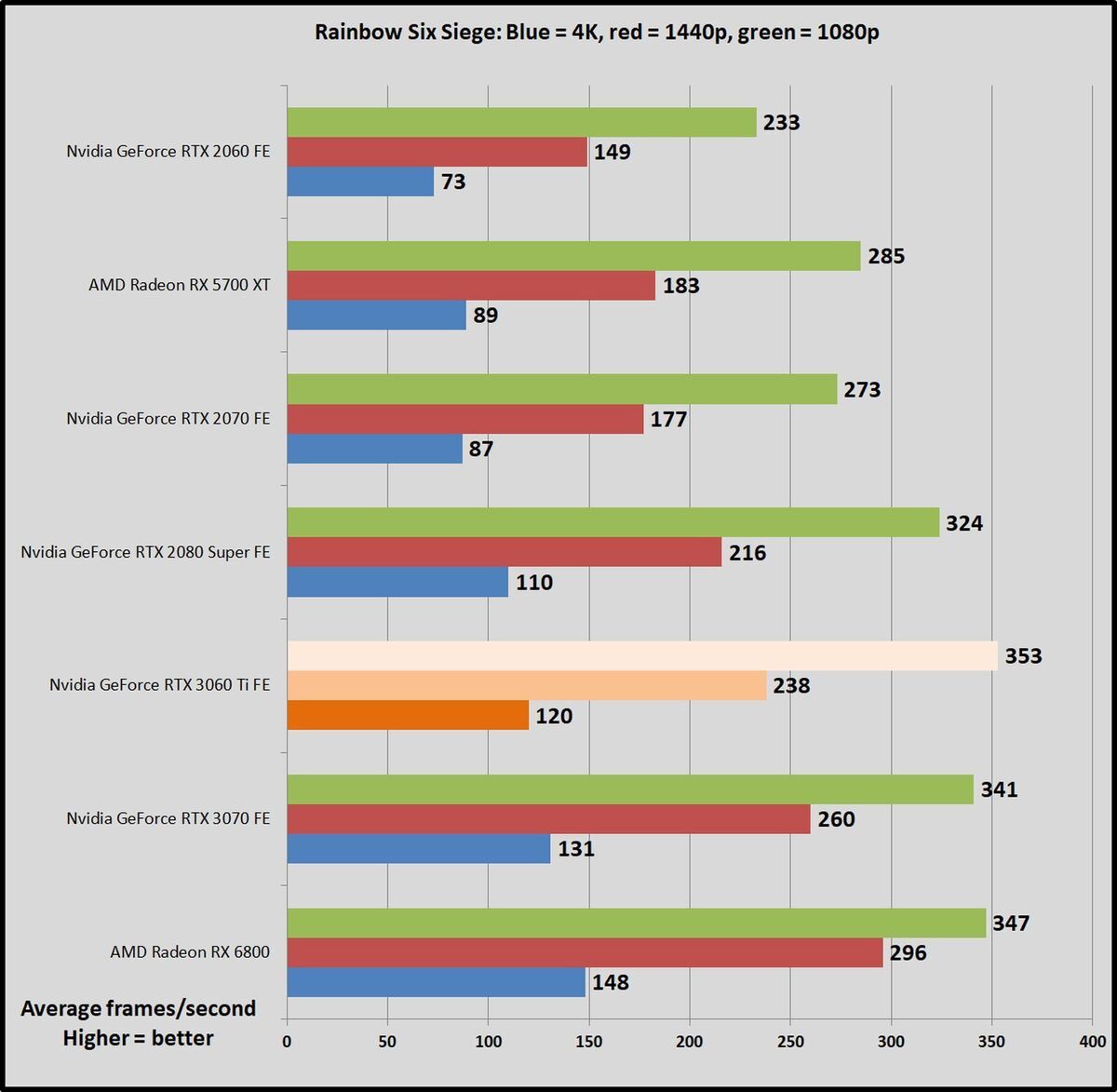 Brad Chacos/IDG
Brad Chacos/IDG Next page: GeForce RTX 3060 Ti ray tracing benchmarks
GeForce RTX 3060 Ti irradiatio tracing benchmarks
Patc we were busy running benchmarks, we flipped along real-time ray tracing and Nvidia's Deep Learning Super Sampling in a handful of games. Sanctioning radiate trace imparts a massive performance impact; DLSS's AI-enhanced image upscaling claws a whole sle of those frames back. (DLSS can also be treated separately from ray tracing to drive your in-game put rates beyond what Nvidia's hardware pumps out natively.) We peacenik deeper into Ampere's ray trace and DLSS performance in our RTX 3080 survey if you're interested in Thomas More analysis.
We tried electron beam tracing capabilities set to Ultra in foursome games, for each one deploying a different version of the cutting-butt on lighting engineering. Shadow of the Grave Raider uses (storm!) ray-derived shadows; the ray-traced global illumination in Metro Exodus genuinely transforms the search and feel of that game; Wolfenstein Youngblood and Ubisoft's energetic Watch Dogs Legion ostentate electron beam-copied reflections on the rival Vulkan and DirectX 12 APIs, respectively.Tomb RaiderandMetrouse Nvidia's original DLSS 1.0 implementation, patcWolfensteinandWatch Dogsdeploy the faster, better DLSS 2.0.
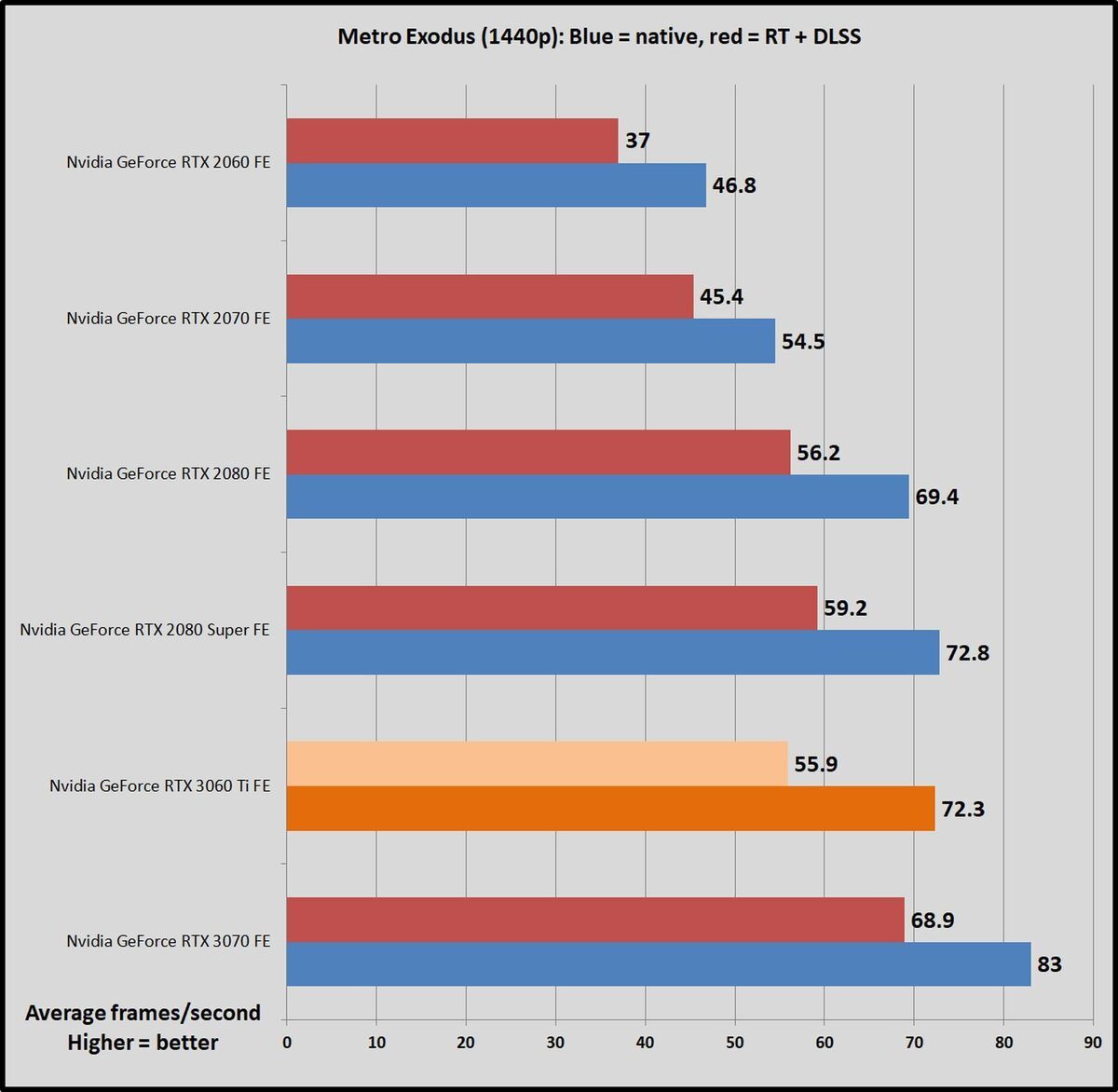 Brad Chacos/IDG
Brad Chacos/IDG 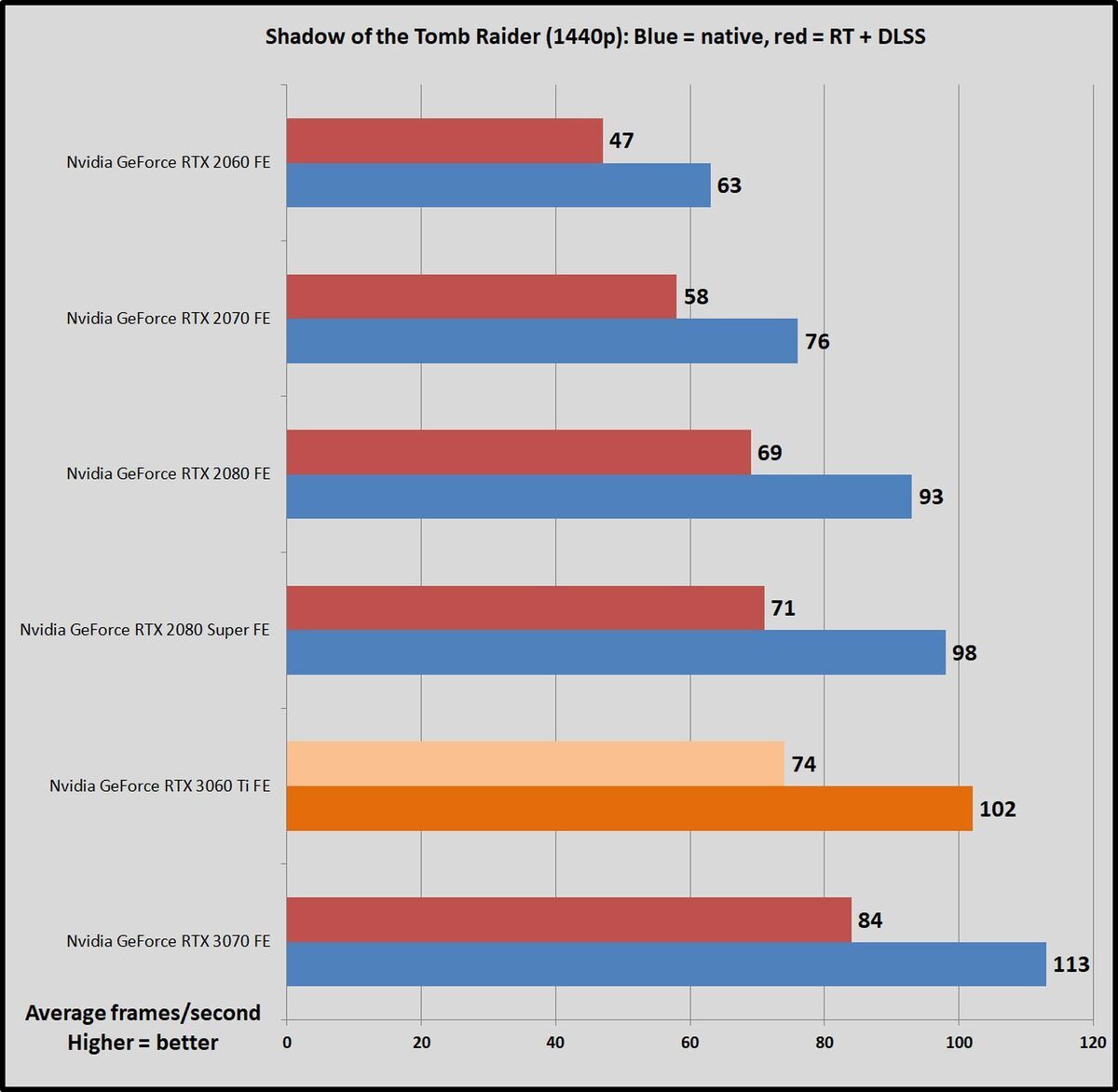 Brad Chacos/IDG
Brad Chacos/IDG 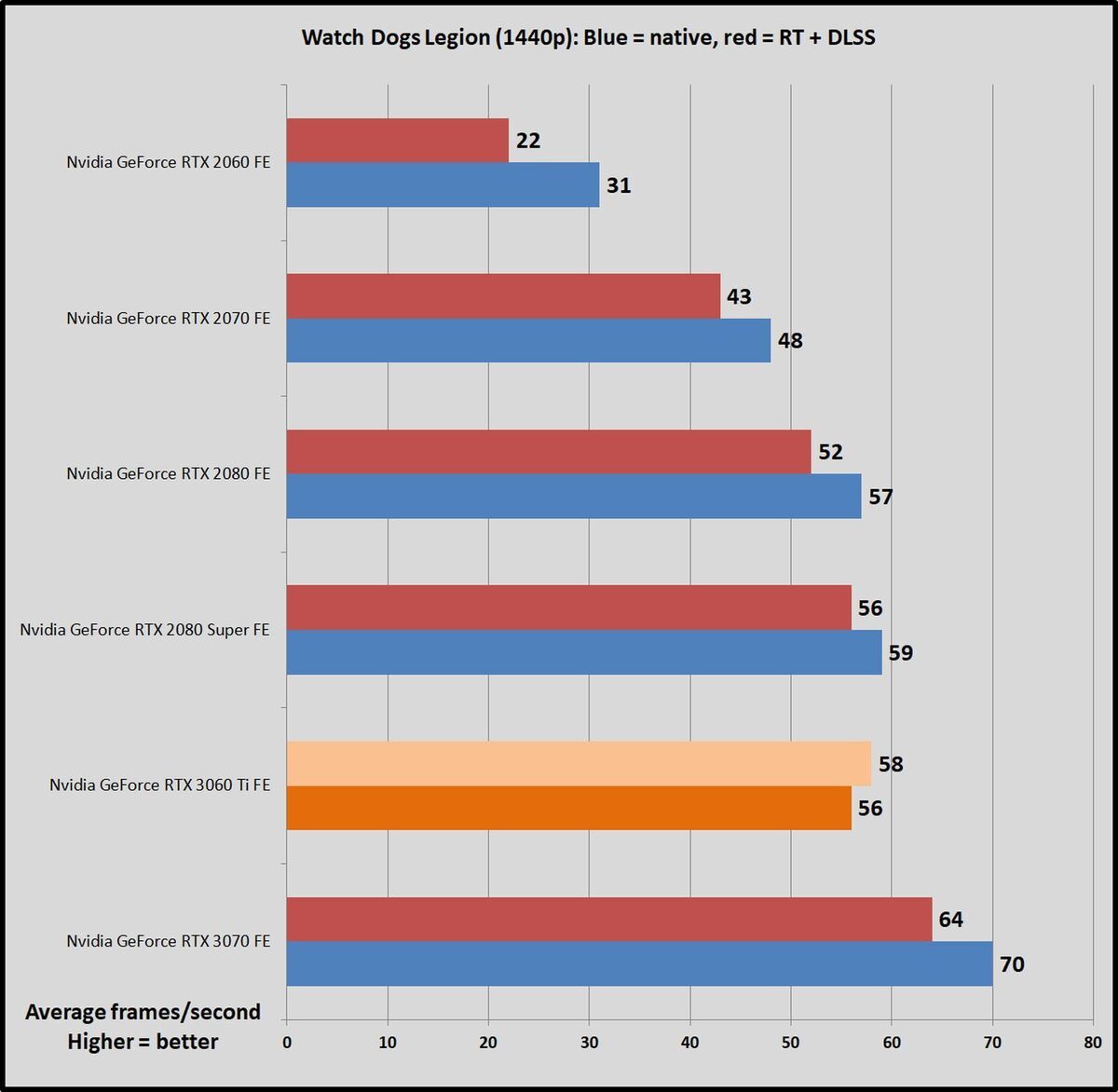 Brad Chacos/IDG
Brad Chacos/IDG 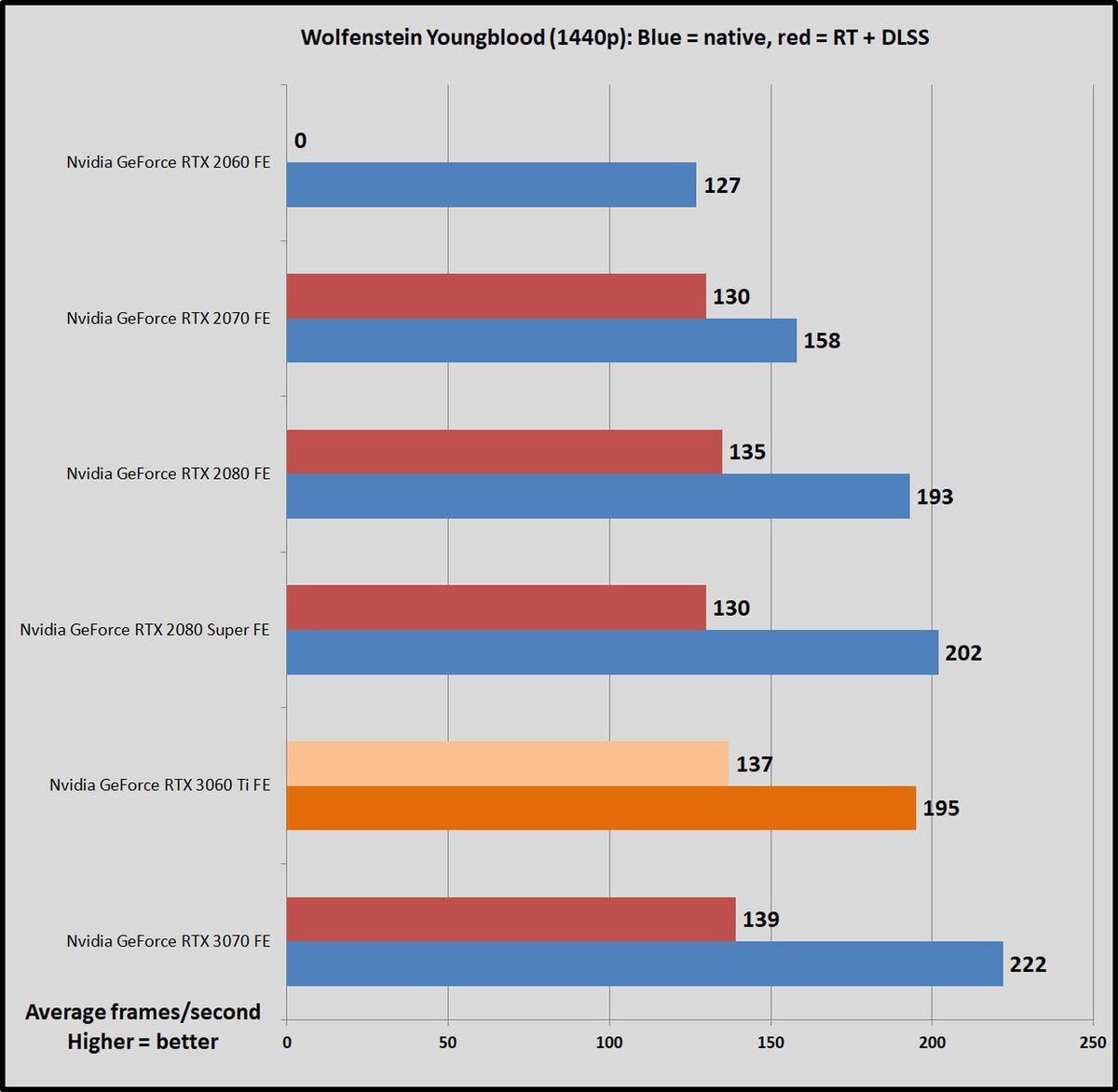 Brad Chacos/IDG
Brad Chacos/IDG No more real surprises here. The GeForce RTX 3060 Ti is or s A fast as the last-gen RTX 2080 Super in traditional gaming performance, and it's roughly atomic number 3 straightaway in radiate tracing public presentation to a fault. The past-gen RTX 2060 FE couldn't even run Wolfenstein with ray tracing enabled. We repeatedly received memory electrical capacity warnings onscreen, then the game crashed.
Next page: Power, thermals, and resound
Power draw, thermals, and dissonance
We test power draw by looping theF1 2020 benchmark at 4K for about 20 minutes after we've benchmarked everything else and noting the highest reading on our Watts Up In favor time, which measures the power consumption of our entire tryout system. The initial disunite of the race, where all competing cars are onscreen simultaneously, tends to be the nigh demanding portion.
This isn't a worst-case test; we far the Core i7 8700K's overclock and specifically chose a GPU-bound game running at a GPU-articled resolution to caliber performance when the graphics add-in is sweating hard. If you're performin a game that also hammers the CPU, you could see higher whole organisation powerfulness draws. Debate yourself warned.
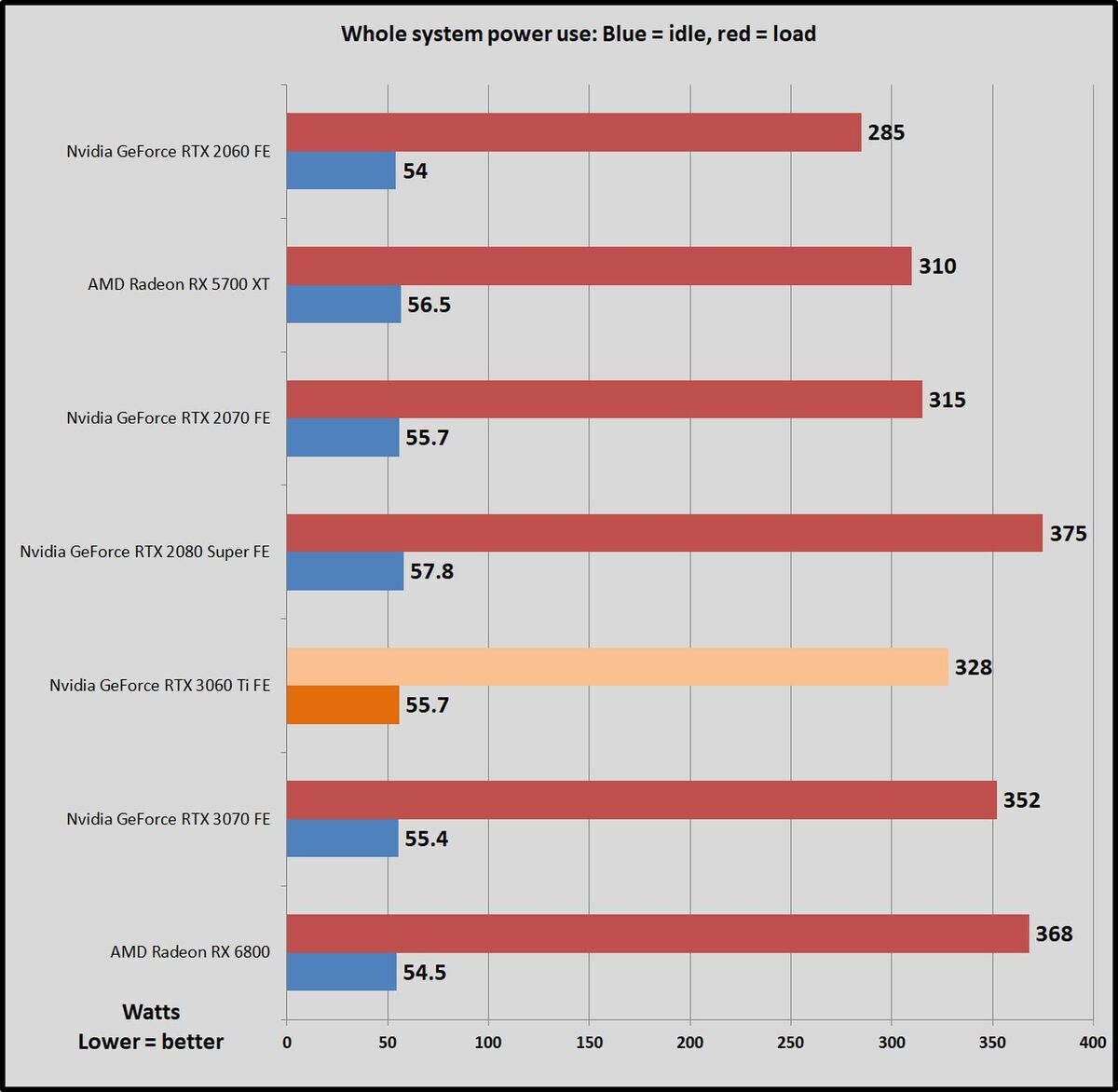 Brad Chacos/IDG
Brad Chacos/IDG The results prove that the Ampere GPU architecture in the RTX 30-series is more power-efficient than the Alan Turing GPUs in last-generation's RTX 20-series card game, simply that the nontextual matter cards themselves draw more top executive in the same class. The RTX 3060 Ti Founders Edition draws a world-shaking 47 watts inferior low-level load than the RTX 2080 Super it topples in performance—a greatest leave—but also draws over 40W more than the RTX 2060 Founders Variant. The new board smokes the older 60-class option in raw performance, though.
We prove thermals away leaving GPU-Z open during theF1 2020 power draw test, noting the highest maximum temperature at the destruction.
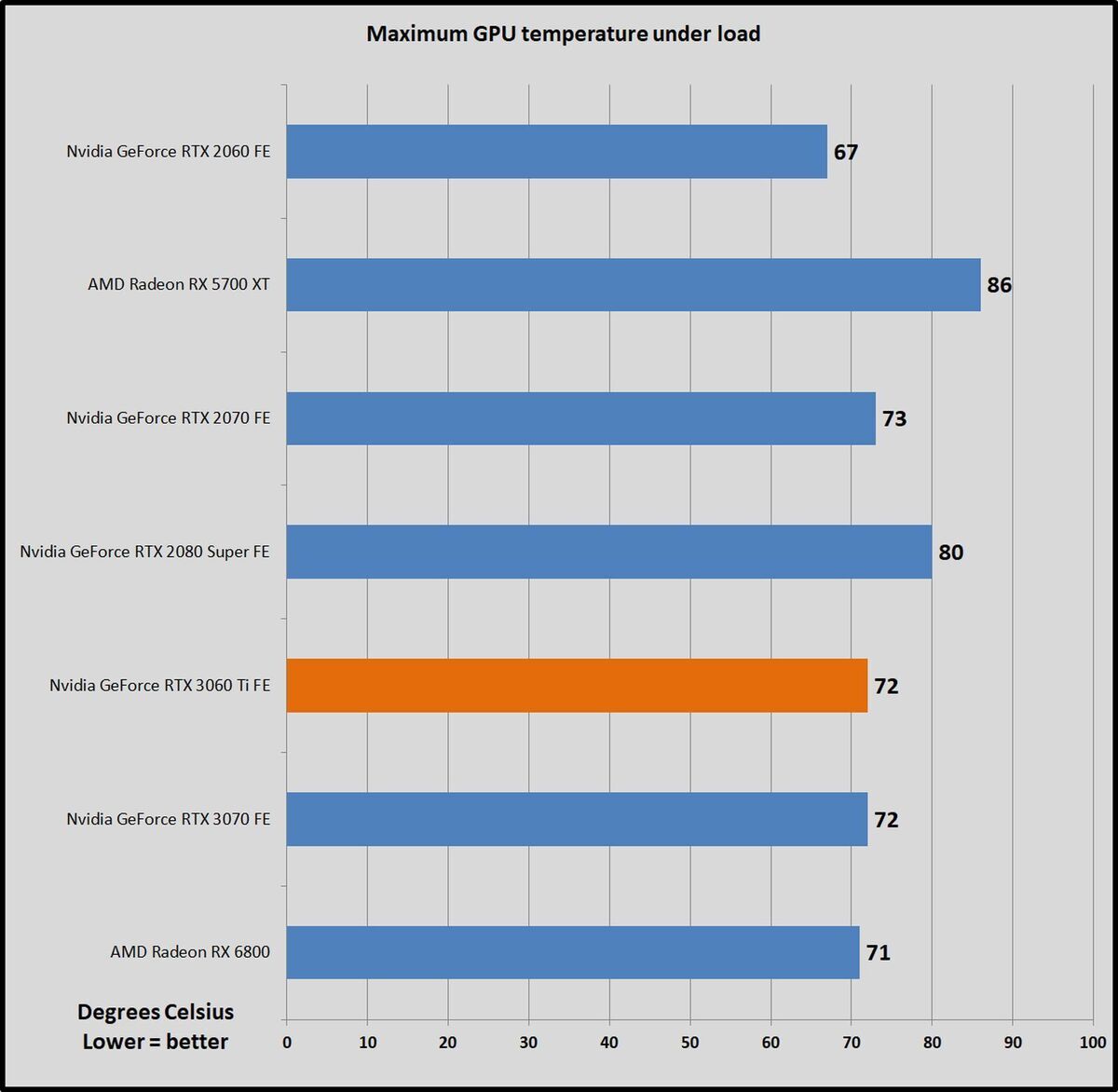 Brad Chacos/IDG
Brad Chacos/IDG Nvidia's radical parvenue ice chest continues to impress as it moves down the Founders Version product stack. Maxing out at a mere 72 degrees under load is a fantastic result for a consultation(ish) nontextual matter card, and significantly cooler than the RTX 2080 Fantastic achieved with similar performance levels. Yet IT quieten leaves room for custom variants by partners similar Asus, MSI, and EVGA to improve things—especially noise levels.
This is the same cooler innovation found on the RTX 3070 FE, pregnant IT not only delivers identical temperature performance, but as wel natural philosophy results. While the strong version of the cooler on Nvidia's more expensive $700 RTX 3080 Fe wasveryquiet, the much smaller RTX 3060 Ti and 3070 Founders Edition models sounds like acceptable graphics cards–moderately loud.
Close page: Should you buy the GeForce RTX 3060 Ti?
Should you steal the GeForce RTX 3060 Ti?
Absolutely—if you can find information technology in this passing supply-limited, demand-profound year. The $400 GeForce RTX 3060 Ti is a spectacular graphics card that delivers performance a hair faster than last-propagation's $800 RTX 2080 First-rate in both traditional and ray derived games for fractional the price, and with lower power consumption. Hot damn.
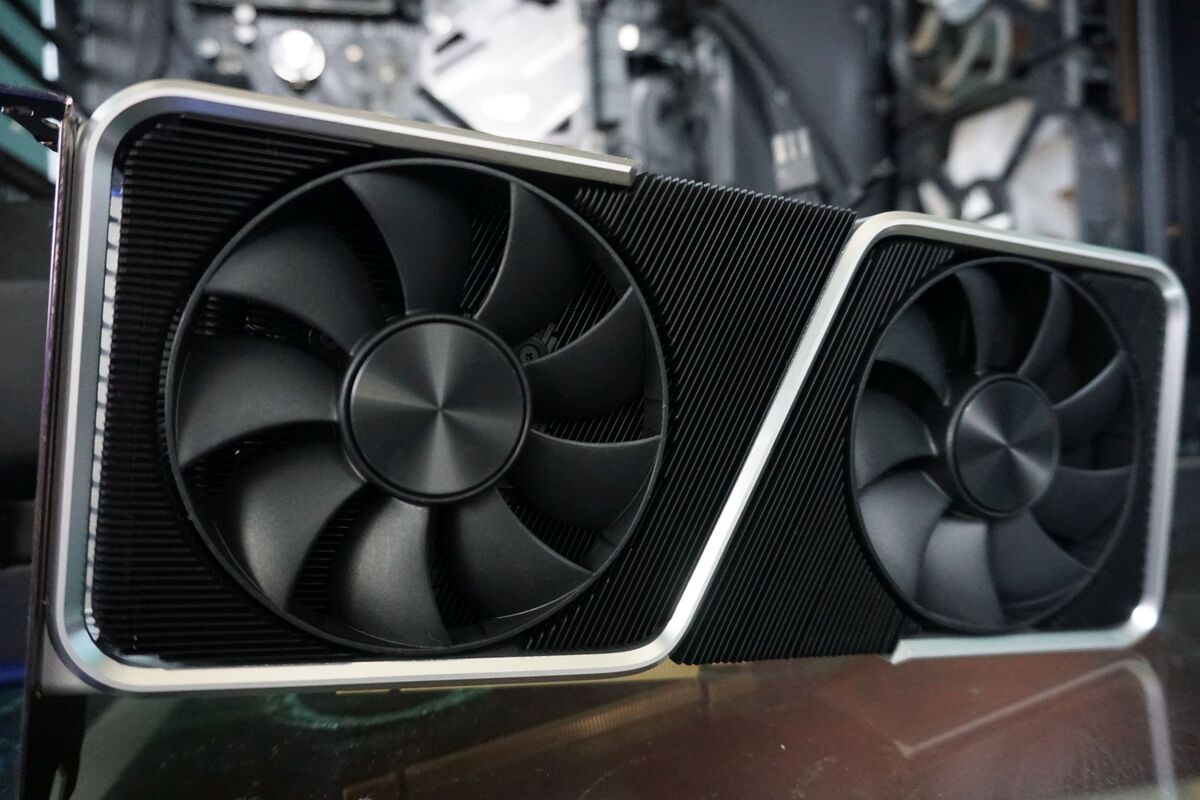 Brad Chacos/IDG
Brad Chacos/IDG That performance paired with 8GB of GDDR6 memory makes the GeForce RTX 3060 Ti a fantastic 1440p gaming alternative. It exceeds the hallowed 60-frames-per-second patsy in all game tested at that firmness of purpose, even with the most strenuous visual settings enabled. It flies well beyond that soft touch in several games, and it should cause no problem holding 90 FPS+ at 1440p in most titles if you don't mind playing minor tuning on graphics options. The RTX 3060 Ti would as wel be a fine union for a tall-refresh-rate 1080p monitor, though AMD's inevitable counterpunch may prevail at those settings, disposed the Radeon RX 6800-serial publication' superior performance at lower resolutions. Nvidia's GPUs handle ray tracing untold break than Radeon cards, all the same, and AMD has no answer to Nvidia's fantastic DLSS tech.
You potty even run games at 4K at a mulct clip with this card if you gibbousness nontextual matter from Ultra to High in most games, Eastern Samoa you could with the elderly RTX 2080 Super. The 8GB memory mental ability likely won't hold up well over the long term, notwithstandin. We'd recommend opting for a nontextual matter card with Sir Thomas More VRAM if you're purchasing for 4K nowadays—either the AMD Radeon RX 6800-series or Nvidia's GeForce RTX 3080. Those card game toll substantially more, though.
The step-rising $500 GeForce RTX 3070 also comes with 8GB of GDDR6 memory, then it's in the running if you're looking for a 1440p graphics scorecard. It's only when 9 percent to 15 percent faster than the RTX 3060 Ti at 1440p depending on the pun, however, for 25 percent more cash. That makes the RTX 3060 Ti a better option for most people, though the RTX 2070's operation boost whitethorn be worthwhile if you storage area onto your nontextual matter cards for an specially years before upgrading again. The extra frames also make the RTX 3070 wagerer for entry-level 4K gaming, though again, we'd cost leery about its 8GB of VRAM at that capacity.
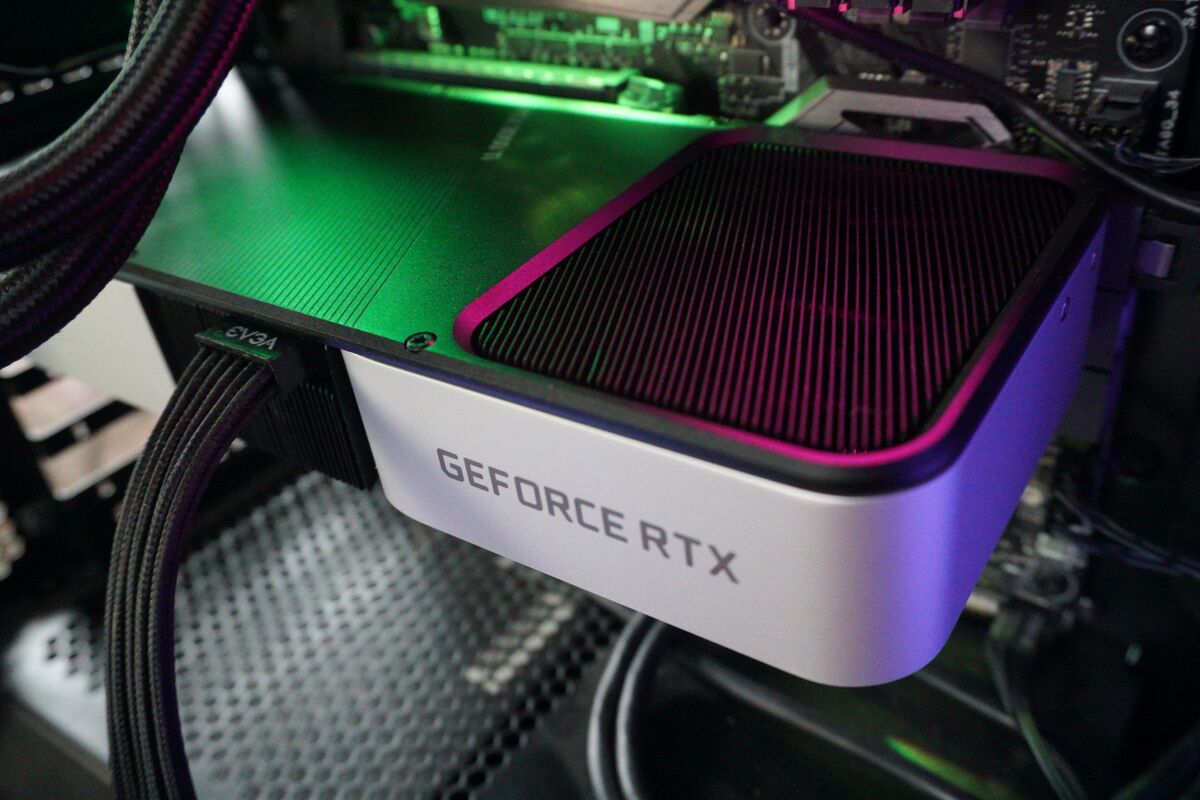 Brad Chacos/IDG
Brad Chacos/IDG At $400, the GeForce RTX 3060 Ti immediately kills some remaining value proposition for comparable last-gen graphics cards like the Radeon RX 5700, 5700 XT, GeForce RTX 2060, and 2060 Super, unless you score one at a monumental discount. Don't count out happening seeing those discounts in today's economy, though. Rather than splurging on older tech at this point, be patient and hold off to get your hands on this GPU.
Nvidia's unorthodox RTX 30-serial Founders Edition cooling continues to impress, though less so the further we move down the stack. The GeForce RTX 3060 Ti FE's 72-degree Anders Celsius temperatures and soft, but audible noise levels don't let down, especially for a card made by Nvidia itself, but there is room for collaborator cards from EVGA, Asus and others to improve things. (Stay tuned for many custom RTX 3060 Ti reviews in the coming days—we've already got several in our custody.) We still dislike the proprietary 12-pin power connector that Nvidia used with its Founders Edition cards this genesis to squeeze in a smaller PCB. The company includes an adapter in the package, but that transcriber is too short and looks squat and ugly compared to nicer traditional cabling options.
Don't let that deter you, though. Functioning this hot cost twice as much last generation and landed near the top of the RTX 20-series muckle. Getting this a lot eye candy for $400 is identical welcome indeed. The GeForce RTX 3060 Titanium is spectacular—a virtually flawless 1440p GPU, minor Founders Edition design squabbles aside. Hera's hoping stocks are copious and bespoke variants aren't priced equally extravagantly as the higher-up RTX 30-series options, because this GPU should sell like hotcakes.
Best Prices Today

$400

$1,329.98
Government note: When you purchase something afterward clicking links in our articles, we English hawthorn earn a little commission. Read our affiliate link policy for more details.
Brad Chacos spends his days dig through desktop PCs and tweeting too much.
Source: https://www.pcworld.com/article/393767/nvidia-geforce-rtx-3060-ti-founders-edition-review.html
Posted by: davidsonagainto.blogspot.com

0 Response to "Nvidia GeForce RTX 3060 Ti Founders Edition review: Spectacular 1440p - davidsonagainto"
Post a Comment